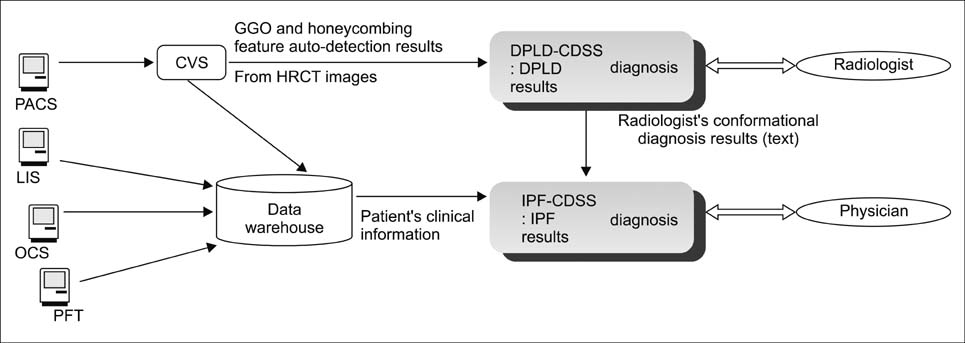Healthc Inform Res.
2010 Dec;16(4):260-272. 10.4258/hir.2010.16.4.260.
Integration and Evaluation of Clinical Decision Support Systems for Diagnosis Idopathics Pulmonary Fibrosis (IPF)
- Affiliations
-
- 1Graduate School of Information, Yonsei University, Seoul, Kore. yunilee@yonsei.ac.kr
- 2Graduate School of Public Health, Yonsei University, Seoul, Kore.
- 3Division of Pulmonology , Severance Hospital, Yonsei University College of Medicine, Seoul, Kore.
- KMID: 2284539
- DOI: http://doi.org/10.4258/hir.2010.16.4.260
Abstract
OBJECTIVES
The purpose of this study was to develop clinical decision support systems (CDSS) that are integrated with hospital information systems for the differential diagnosis of idiopathic pulmonary fibrosis (IPF).
METHODS
The integrated CDSS were validated and evaluated by physicians. Knowledge modeling for diagnosing IPF was performed by knowledge working groups, composed of radiologists and respiratory specialists. In order to develop the model for CDSS diagnosis, the clinical cases were collected from 290 cases from Seoul National University Hospital and Sevrance Hospital of Yonsei University. For the evaluation of integrated CDSS, interviews were conducted with respiratory specialists and radiologist 2 weeks after applying CDSSs in clinical settings. The CDSS was integrated with the computer vision system (CVS) and diffuse parenchymal lung diseases (DPLD), CDSS developed in our previous project.
RESULTS
Eighteen cases diagnosed as IPF were applied to the collection of diagnostic knowledge and the refined knowledge, the former diagnosed 1 case (6%) and the latter diagnosed 14 cases (78%). Therefore, the refined knowledge performed better than collected knowledge. The validation results of integrated CDSSs showed that 81 cases (74.3%) were diagnosed correctly.
CONCLUSIONS
There were 109 cases of IPF diagnosed and initiated on treatment. The significance of this study is in developing integrated CDSS with PACS by acquiring and redefining the knowledge needed for IPF diagnosis. In addition, it is significant for the integration of CDSS to verification and clinical evaluation.
Keyword
MeSH Terms
Figure
Reference
-
1. Macedo P, Coker RK, Partridge MR. Is there a uniform approach to the management of diffuse parenchymal lung disease (DPLD) in the UK? A national benchmarking exercise. BMC Pulm Med. 2007. 7:3.
Article2. King T. Approach to the adult with interstitial lung diseases [Internet]. c2010. cited at 2010 Dec 24. Waltham, MA: UpToDate Inc.;Available from: http://www.uptodate.com/patients/content/topic.do?topicKey=~r.rZ_nPHQtOdHKu.3. Demedts M, Wells AU, Anto JM, Costabel U, Hubbard R, Cullinan P, Slabbynck H, Rizzato G, Poletti V, Verbeken EK, Thomeer MJ, Kokkarinen J, Dalphin JC, Newman Taylor A. Interstitial lung diseases: an epidemiological overview. Eur Respir J Suppl. 2001. 32:2s–16s.4. British Thoracic Society. The diagnosis, assessment and treatment of diffuse parenchymal lung disease in adults. Thorax. 1999. 54:S1–S28.5. Khalil N, O'Connor R. Idiopathic pulmonary fibrosis: current understanding of the pathogenesis and the status of treatment. CMAJ. 2004. 171:153–160.
Article6. American Thoracic Society. Idiopathic pulmonary fibrosis: diagnosis and treatment. International consensus statement. Am J Respir Crit Care Med. 2000. 161:646–664.7. Goh NS, du Bois RM. Gibson GJ, Geddes DM, Costabel U, Sterk P, Corrin B, editors. Idiopathic pulmonary fibrosis and related disorders. Respiratory medicine. 2003. Edinburgh, UK: Saunders;1557–1566.8. Drent M, du Bois RM, Poletti V. Recent advances in the diagnosis and management of nonspecific interstitial pneumonia. Curr Opin Pulm Med. 2003. 9:411–417.
Article9. Demedts M, Costabel U. ATS/ERS international multidisciplinary consensus classification of the idiopathic interstitial pneumonias. Eur Respir J. 2002. 19:794–796.
Article10. Swensen SJ, Aughenbaugh GL, Myers JL. Diffuse lung disease: diagnostic accuracy of CT in patients undergoing surgical biopsy of the lung. Radiology. 1997. 205:229–234.
Article11. American Thoracic Society. European Respiratory Society. American Thoracic Society/European Respiratory Society international multidisciplinary consensus classification of the idiopathic interstitial pneumonias. Am J Respir Crit Care Med. 2002. 165:277–304.12. Liebowitz J. The handbook of applied expert ssstems. 1998. Boca Raton, FL: CRC Press;1–20.13. Lee YH, Chae YM, Kim JH, Han DH, Jeon SW, Han H. Integration of clinical decision support system and the computer vision module for the diagnosis of Diffuse interstitial lung disease (DILD). J Korean Soc Med Inform. 2005. 11:Suppl 1. S65–S69.14. Geissbuhler A, Miller RA. Clinical application of the UMLS in a computerized order entry and decision-support system. Proc AMIA Symp. 1998. 320–324.15. Bontempo C, Zagelow G. The IBM data warehouse architecture. Commun ACM. 1998. 41:38–48.
Article16. The diagnosis, assessment and treatment of diffuse parenchymal lung disease in adults. Introduction. Thorax. 1999. 54:S1–S14.17. Hunninghake GW, Lynch DA, Galvin JR, Gross BH, Müller N, Schwartz DA, King TE Jr, Lynch JP 3rd, Hegele R, Waldron J, Colby TV, Hogg JC. Radiologic findings are strongly associated with a pathologic diagnosis of usual interstitial pneumonia. Chest. 2003. 124:1215–1223.
Article18. du Bois RM, Wells AU. Cryptogenic fibrosing alveolitis/idiopathic pulmonary fibrosis. Eur Respir J Suppl. 2001. 32:43s–55s.19. Churg A, Schwarz M. Transbronchial biopsy and usual interstitial pneumonia: a new paradigm? Chest. 2006. 129:1117–1118.
Article20. White ES, Lazar MH, Thannickal VJ. Pathogenetic mechanisms in usual interstitial pneumonia/idiopathic pulmonary fibrosis. J Pathol. 2003. 201:343–354.
Article21. Berbescu EA, Katzenstein AL, Snow JL, Zisman DA. Transbronchial biopsy in usual interstitial pneumonia. Chest. 2006. 129:1126–1131.
Article22. Flaherty KR, Martinez FJ. The role of pulmonary function testing in pulmonary fibrosis. Curr Opin Pulm Med. 2000. 6:404–410.
Article23. Erbes R, Schaberg T, Loddenkemper R. Lung function tests in patients with idiopathic pulmonary fibrosis. Are they helpful for predicting outcome? Chest. 1997. 111:51–57.
Article24. Hunninghake GW, Zimmerman MB, Schwartz DA, King TE Jr, Lynch J, Hegele R, Waldron J, Colby T, Müller N, Lynch D, Galvin J, Gross B, Hogg J, Toews G, Helmers R, Cooper JA Jr, Baughman R, Strange C, Millard M. Utility of a lung biopsy for the diagnosis of idiopathic pulmonary fibrosis. Am J Respir Crit Care Med. 2001. 164:193–196.
Article
- Full Text Links
- Actions
-
Cited
- CITED
-
- Close
- Share
- Similar articles
-
- Update in Diagnosis of Idiopathic Pulmonary Fibrosis and Interstitial Lung Abnormality
- Pharmacological treatment of idiopathic pulmonary fibrosis and fibrosing interstitial lung diseases: current trends and future directions
- New Guidelines for Idiopathic Pulmonary Fibrosis and Progressive Pulmonary Fibrosis
- Pathogenesis and New Diagnosis Guideline of Idiopathic Pulmonary Fibrosis
- Diagnosis and treatment of interstitial lung disease: focusing on idiopathic pulmonary fibrosis




